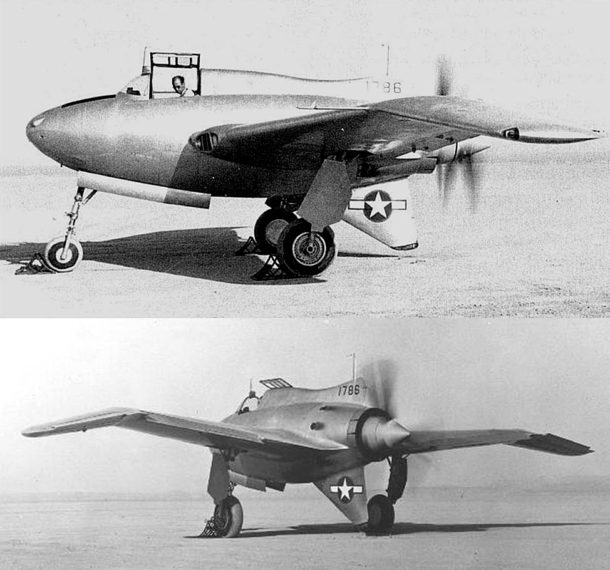
Seventy-four years ago this month, flight testing of the USAAF/Northrop XP-56 Black Bullet commenced at Army Air Base, Muroc in California. Northrop Chief Test Pilot John W. Myers was at the controls of the experimental pursuit aircraft.
The XP-56 (X for Experimental, P for Pursuit) was an attempt at producing a combat aircraft that had superior speed performance relative to conventional fighter-like airframes of the early 1940’s. Towards this end, designers sought to maximize thrust and minimize weight and aerodynamic drag. The product of their labors was a truly strange aircraft configuration.
The XP-56 was essentially a hybrid flying wing to which was added a stubby fuselage to house the pilot and engine. Power was provided by a single Pratt and Whitney R-2800 radial piston engine driving contra-rotating propellers. A pusher power plant installation was selected in the interest of reducing forebody drag. Gross Take-Off Weight (GTOW) came in at 11,350 lbs.
The XP-56’s wing featured a leading edge sweep of 32 degrees and a span of 42.5 feet. The tiny fuselage length of 27.5 feet necessitated the use of elevons for pitch and roll control. Aft-mounted dorsal and ventral tails contributed to directional stability while yaw control was provided by a rudder mounted in the ventral tail.
Under contract to the United States Army Air Force (USAAF), Northrop built a pair of XP-56 airframes; Ship No. 1 (S/N 41-786) and Ship No. 2 (S/N 42-38353). Top speed was advertised as 465 mph at 25,000 feet while the design service ceiling was estimated to be around 33,000 feet. The XP-56 was a short-legged aircraft, having a predicted range of only 445 miles at 396 mph.
XP-56 Ship No. 1 took to the air for the first time on Monday, 06 September 1943. The scene was Rogers Dry Lake at Army Air Field, Muroc (today’s Edwards Air Force Base) in California. Northrop Chief Test Pilot John W. Myers had the distinction of piloting the XP-56. As described below, this distinction was dubious at best.
Myers actually flew XP-56 Ship No. 1 twice on the type’s inaugural day of flight testing. The first flight was really just a hop in the air. Using caution as a guide, Myers flew only 5 feet off the deck in a 30 second flight that covered a distance on the order of 1 mile. The aircraft registered a top speed 130 mph. While the XP-56 exhibited a nose-down pitch tendency as well as lateral-directional sensitivities, Myers was able to complete the flight.
The XP-56’s second foray into the air nearly ended in disaster. Shortly after lift-off at 130 mph, the XP-56 presented pilot Myers with a multi-axis control problem about 50 feet above the surface of Rogers Dry Lake. The strange-looking ship simultaneously yawed to the left, rolled to the right, and pitched down. Holding the control stick with both hands, it was all the Northrop Chief Test Pilot could do keep the nose up and prevent the XP-56 from diving into the ground.
Myers attempted to throttle-back as his errant steed passed through 170 mph. The anomalous yawing-rolling-pitching motions reappeared at this point, once again testing Myers’ piloting skills to the max. The intrepid pilot was finally able to get the XP-56 back on the ground. Albeit, the landing was more of a controlled crash. All of this excitement took place in about 60 seconds over a two mile stretch of Rogers Dry Lake. John Myers had certainly earned his flight pay for the day.
XP-56 Ship No. 1 was demolished during a take-off accident on Friday, 08 October 1943. Although he sustained minor injuries, Myers survived the incident thanks largely to wearing an old polo helmet to protect his valuable cranium. Following the mishap , Myers said that “the airplane wanted to fly upside down and backwards, and finally did!”
XP-56 Ship No. 2 flew a total of ten (10) flights between March and August of 1944. Northrop test pilot Harry Crosby did the piloting honors this time around. Like Myers, Crosby had his hands full trying to fly the XP56. However, Crosby was able to coax the XP-56 up to 250 mph.
Despite valiant attempts to rectify the XP-56’s curious and dangerous handling qualities, Northrop engineers were never able to satisfactorily correct the little beast’s ills. This, coupled with the facts that the XP-56 (1) did not deliver the promised speed performance and (2) was being eclipsed by rapid developments in aircraft technology, the strange aerial concoction became a faded memory by 1945.
A final thought. Just why the XP-56 was given the nickname of Black Bullet is not clear. Ship No. 1 was bare metal and thus silver in appearance. Ship No. 2 sported a dark grey and green camouflage paint scheme. The Bullet moniker could be in deference to the bullet-like nose of the fuselage. In the final analysis, the name Black Bullet probably just sounded cool and evoked a stirring image of a bullet speeding to the target!

